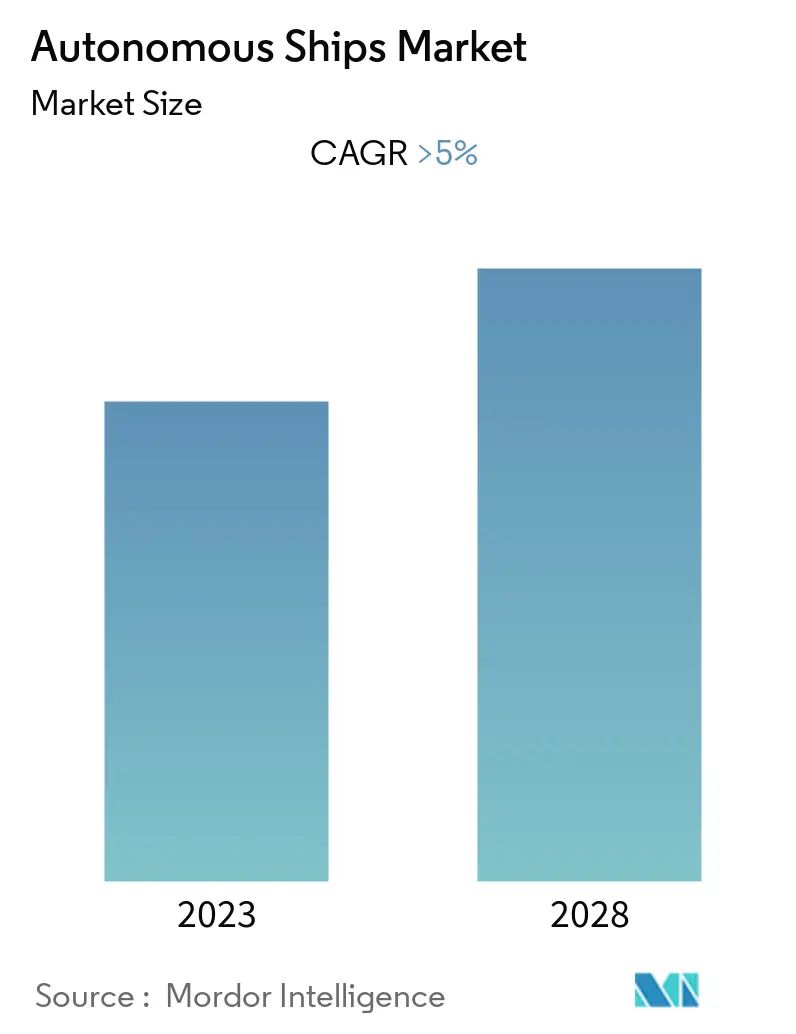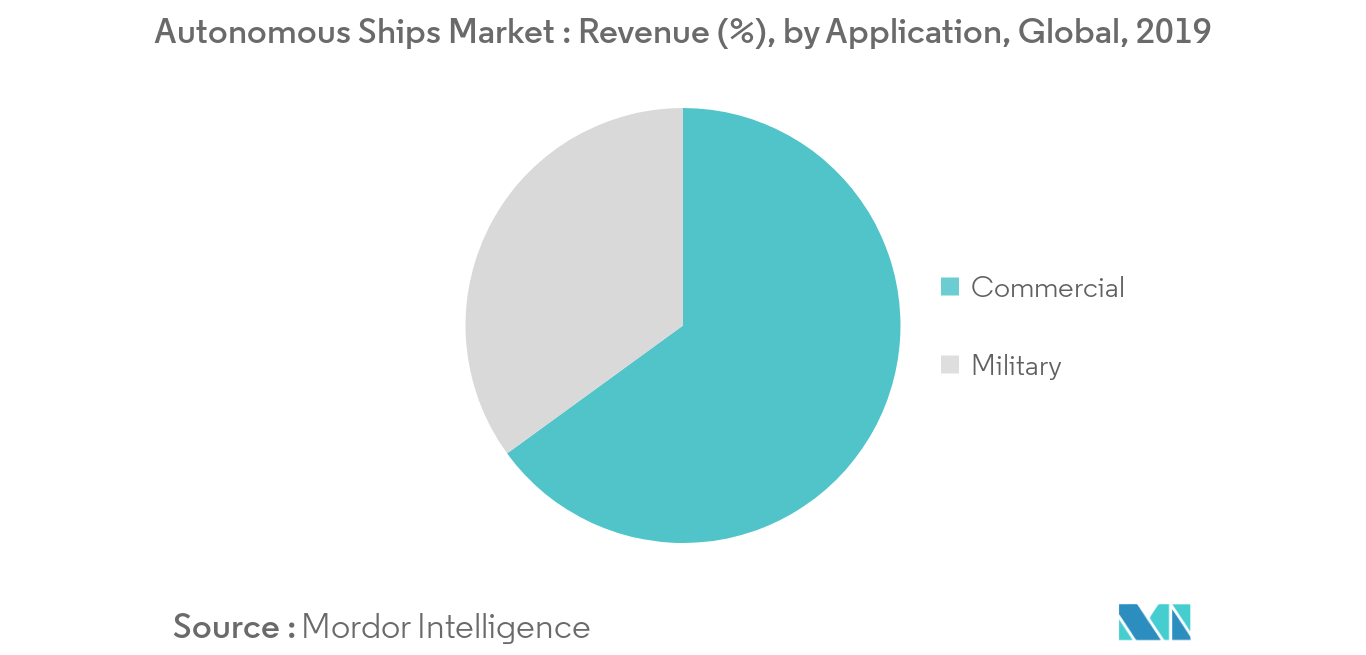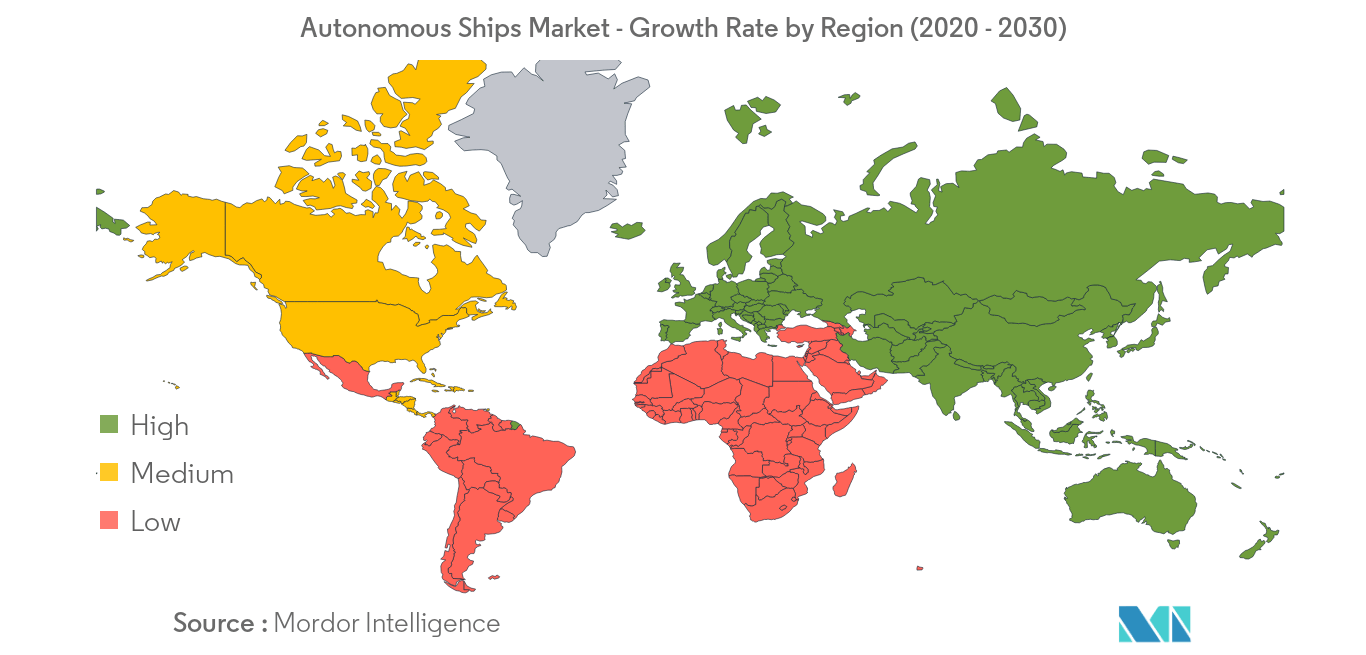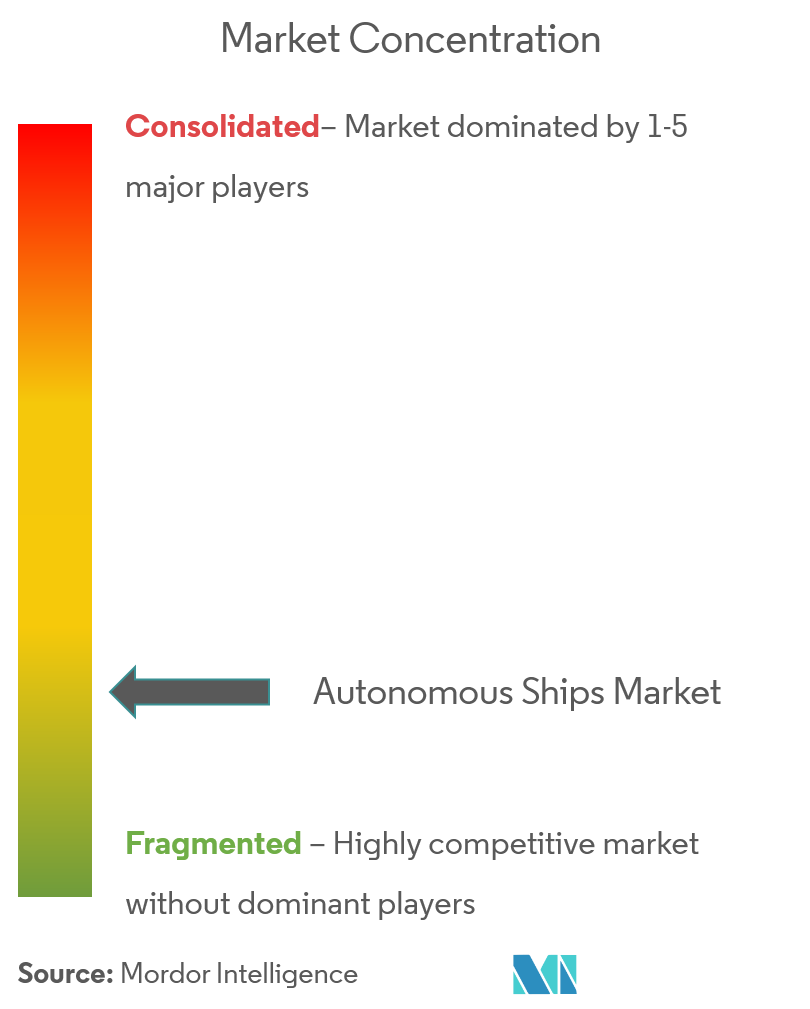Autonomous Ships Market Size

| Study Period | 2018 - 2028 |
| Base Year For Estimation | 2021 |
| Forecast Data Period | 2024 - 2028 |
| CAGR | > 5.00 % |
| Fastest Growing Market | Europe |
| Largest Market | Europe |
Major Players
*Disclaimer: Major Players sorted in no particular order |
Need a report that reflects how COVID-19 has impacted this market and its growth?
Autonomous Ships Market Analysis
The autonomous ships market is anticipated to register a CAGR of above 5% during the forecast period.
- The demand for autonomous and remotely controlled ships is growing at a rapid pace, due to the developments in sensor technology, connectivity at sea, and analysis and decision support software and algorithms (artificial intelligence) for various onboard applications, like navigation and situational awareness.
- The autonomy of the shipping industry is expected to reduce the maritime emissions, enable massive fuel savings, and save about 20% of the cost incurred for the shipping operators. Additionally, according to the European Maritime Safety Agency (EMSA), 58% of accidental events and 70% of accidental events were attributed to human error on shipboard operations. This technology is anticipated to apprehend such accidents due the human error on the bridges of the vessel, thereby, reducing the accidents onboard.
- In several countries, like Finland, the United Kingdom, Norway, South Korea, China, and Japan, various companies (in different industries, like shipbuilding, engine manufacturers, big data, and other software providers) are collaborating and forming research alliances to increase the human-machine interface and incorporate autonomy into the naval architecture. Such collaborations are expected to propel the growth of the market during the forecast period.
- The cost for integration of autonomy into naval vessels, the threat of cybersecurity, and the reliability of software and machinery aboard the vessels are anticipated to act as barriers for the growth of the autonomous ships market during the forecast period.
Autonomous Ships Market Trends
This section covers the major market trends shaping the Autonomous Ships Market according to our research experts:
The Commercial Segment of the Market is Anticipated to Register the Highest Growth During the Forecast Period
The development of new autonomous naval vessels with the advancement of technologies and the incorporation of sensor systems in commercial vessels, like cargo vehicles, passenger ferries, and other platforms, are anticipated to propel the growth of autonomy in the commercial segment. Integration of autonomy is a costly and slow process, especially in the maritime industry, as the adoption rate of new technologies is relatively slower compared to other transportation systems. Therefore, commercial operators are starting with remote-controlled vessels and making long term plans to replace traditional ships with autonomous ships. Some of the liner shipping companies, like Maersk, CMA CGM, and Hapag-Lloyd, and cruise operators have established remote operating centers (ROCs) for their fleets for several years. These help in monitoring the data on the bridge and assist the crew on board in operating the vessel. Additionally, Yara Birkeland is an autonomous 120 TEU container ship, which is currently under construction. Yara International plans to launch manned vessels in 2020 initially. With steady implementations of autonomous functions, the vessel is anticipated to perform autonomous unmanned operations by 2022. Some of the companies are collaborating with technology providers and accelerating the development of new autonomous ships. For instance, Rolls Royce, one of the pioneers of the autonomous technology, successfully demonstrated Falco, the world’s first fully autonomous ferry, in December 2018 in collaboration with Finferries, the Finnish state-owned ferry operator.

The Europe Region is Expected to Generate the Highest Demand During the Forecast Period
The increasing investments and initiatives from the European governments and companies into autonomous ships are majorly driving the growth of the market. One Sea – Autonomous Maritime Ecosystem is the major European collaboration by ABB, Ericsson, Cargotec (MacGregor and Kalmar), Meyer Turku, Rolls-Royce Holding PLC, Tieto, and Wärtsilä Corporation that began in 2016, with the aim to enable commercial autonomous maritime traffic by 2025. Similarly, Finnish-based companies are working on a research project called Ecosystem for Autonomous Ships, a collaborative platform that aims to introduce the world’s first autonomous marine transport system by 2025. In addition to this, the companies are supporting government initiatives to introduce autonomous capability into naval vessels. For instance, DNV GL, a Norway-based company is involved in many projects on autonomous ships. One such project is the Norwegian Forum for Autonomous Ships (NFAS), which is supported by the Norwegian Government. Furthermore, the UK-Norwegian collaborative project called Safe Implementation of Autonomous and Remote Operation of Ships (SIMAROS) plans to develop a fully autonomous offshore vessel, Hrönn. Therefore, such plans to develop and induct autonomous ships may aid the rapid growth of the autonomous ships market in Europe during the forecast period.

Autonomous Ships Industry Overview
The market for autonomous ships is highly fragmented, with many regional players, which are funded by their local governments to collaborate and develop autonomous ships. The prominent players in the autonomous ship market are DNV GL, Kongsberg Gruppen AS, Rolls-Royce Holding PLC, Wärtsilä Corporation, Praxis Automation Technology BV, and Valmet Corp. DNV GL, Kongsberg Gruppen AS, and Rolls-Royce Holding PLC are the manufacturers of the ships, whereas Wärtsilä Corporation, Praxis Automation Technology BV, and Valmet Corp are some of the prominent component providers that support shipbuilding companies with the essential automation technologies. To further integrate the developments in the sensors, Big Data, and artificial intelligence technologies, the shipbuilding companies are collaborating with the IT companies. For instance, in October 2018, Rolls-Royce Holding PLC and Intel entered a partnership for designing sophisticated intelligent shipping systems. These advanced smart connected and data-centric systems are expected to improve the safety of the commercial ships for ship owners, operators, cargo owners, and ports. The new shipping intelligence systems will have a data center and artificial intelligence capabilities, along with sophisticated edge computing throughout, that can independently manage navigation, obstacle detection, and communications. Such collaborations and support from government initiatives are anticipated to maximize the penetration of the market into the shipping industry, which in turn, will help the companies to capitalize on profits.
Autonomous Ships Market Leaders
DNV GL
Kongsberg Gruppen AS
Rolls-Royce Holding PLC
Wärtsilä Corporation
Praxis Automation Technology BV
*Disclaimer: Major Players sorted in no particular order

Autonomous Ships Market News
In October 2021, Yara International (Yara) announced that it has created the world’s first zero-emission, autonomous electric cargo ship to transport goods. The company stated that it aims is to combat climate change on a global scale using its crewless ship, Yara Birkeland.
In September 2021, the design and engineering consultancy BMT unveiled its 'Highly Autonomous Warship Technologies' project, which is designed to help bridge the gap between current vessels and future lean-crewed autonomous warships. The programme aims to understand and enable philosophies behind the future lean crewed warships that are enabled by autonomy.
Autonomous Ships Market Report - Table of Contents
1. INTRODUCTION
1.1 Study Assumptions
1.2 Scope of the Study
2. RESEARCH METHODOLOGY
3. EXECUTIVE SUMMARY
4. MARKET DYNAMICS
4.1 Market Overview
4.2 Market Drivers
4.3 Market Restraints
4.4 Porter's Five Forces Analysis
4.4.1 Bargaining Power of Buyers/Consumers
4.4.2 Bargaining Power of Suppliers
4.4.3 Threat of New Entrants
4.4.4 Threat of Substitute Products
4.4.5 Intensity of Competitive Rivalry
5. MARKET SEGMENTATION
5.1 Type
5.1.1 Partially Autonomous
5.1.2 Remotely Controlled Ship
5.1.3 Fully Autonomous
5.2 Application
5.2.1 Commercial
5.2.2 Military
5.3 Geography
5.3.1 North America
5.3.2 Europe
5.3.3 Asia-Pacific
5.3.4 Rest of the World
6. COMPETITIVE LANDSCAPE
6.1 Vendor Market Share
6.2 Company Profiles
6.2.1 DNV GL
6.2.2 Kongsberg Gruppen AS
6.2.3 Rolls-Royce Holding PLC
6.2.4 NYK Line
6.2.5 Mitsui E&S Holdings Co. Ltd
6.2.6 Wärtsilä Corporation
6.2.7 DSME Co. Ltd
6.2.8 Vigor Industrial LLC
6.2.9 Praxis Automation Technology BV
6.2.10 Valmet Corp
7. MARKET OPPORTUNITIES AND FUTURE TRENDS
Autonomous Ships Industry Segmentation
The International Maritime Organization (IMO) defined maritime autonomous surface ships (MASS) as a ship that, to a varying degree, can operate independently of human interaction. It identified four degrees of autonomy in ships, which are defined as follows:
- Degree one: A ship that is operated by seafarers with some of the processes automated.
- Degree two: Remotely controlled ship, controlled and operated from a different location with seafarers on board.
- Degree three: Remotely controlled ship, controlled and operated from a different location without seafarers on board.
- Degree four: Fully autonomous ship, with an operating system that will make decisions and determine actions by itself.
The military segment of the market study includes autonomous ships and unmanned surface vehicles.
| Type | |
| Partially Autonomous | |
| Remotely Controlled Ship | |
| Fully Autonomous |
| Application | |
| Commercial | |
| Military |
| Geography | |
| North America | |
| Europe | |
| Asia-Pacific | |
| Rest of the World |
Autonomous Ships Market Research FAQs
What is the current Autonomous Ships Market size?
The Autonomous Ships Market is projected to register a CAGR of greater than 5% during the forecast period (2023-2028).
Who are the key players in Autonomous Ships Market?
DNV GL, Kongsberg Gruppen AS, Rolls-Royce Holding PLC, Wärtsilä Corporation and Praxis Automation Technology BV are the major companies operating in the Autonomous Ships Market.
Which is the fastest growing region in Autonomous Ships Market?
Europe is estimated to grow at the highest CAGR over the forecast period (2023-2028).
Which region has the biggest share in Autonomous Ships Market?
In 2023, the Europe accounts for the largest market share in the Autonomous Ships Market.
Autonomous Ships Industry Report
Statistics for the 2023 Autonomous Ships market share, size and revenue growth rate, created by Mordor Intelligence™ Industry Reports. Autonomous Ships analysis includes a market forecast outlook to 2028 and historical overview. Get a sample of this industry analysis as a free report PDF download.
